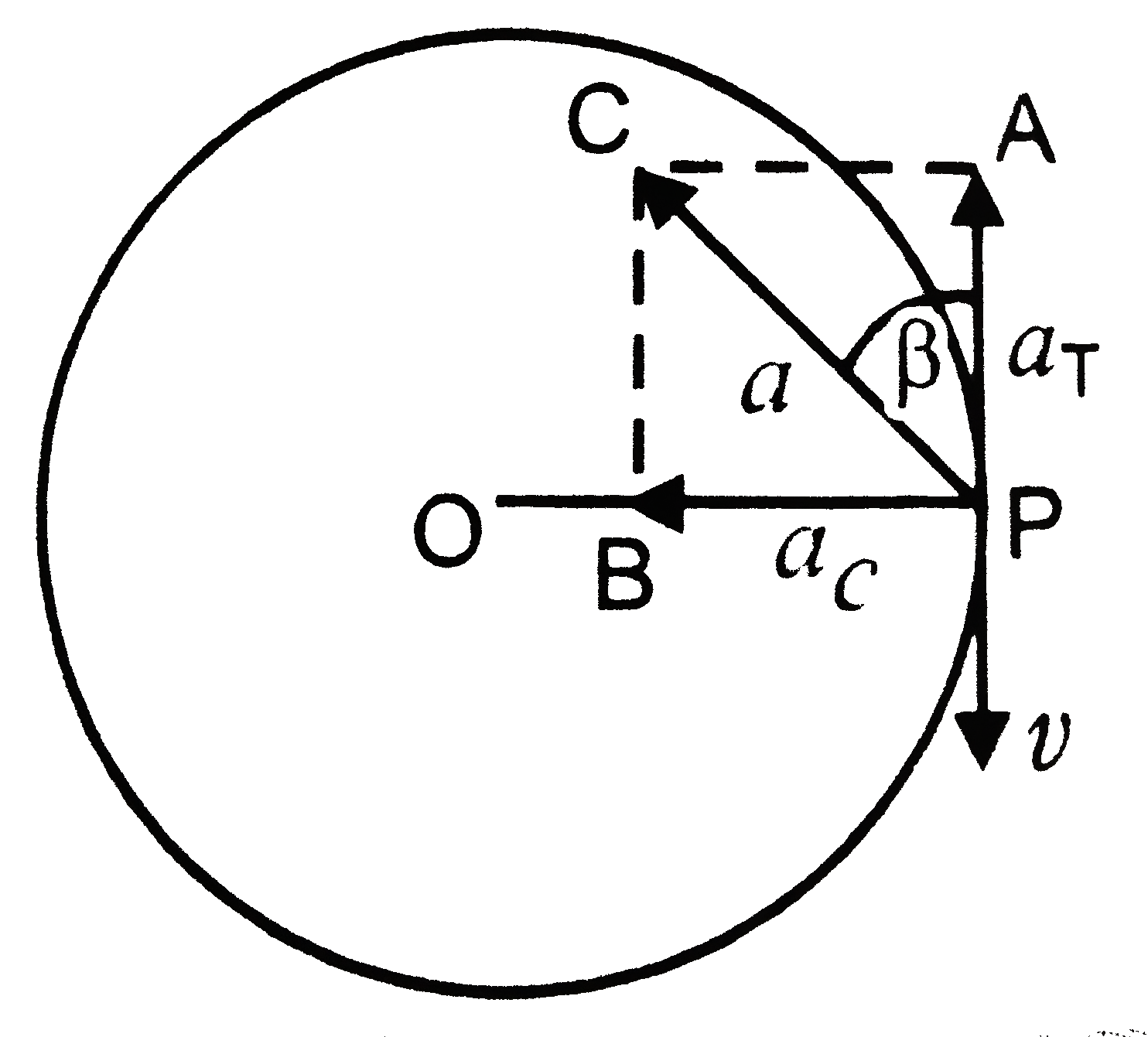A cylclist is riding with a speed of 27kmh−1. As he approaches a circular turn on the road of radius 80m, he applies brakes and reduces his speed at the constant rate of 0.5ms−2. What is the magnitude and direction of the net acceleration of the cyclist on the circular turn ?
Here, v=27kmh−10=27×91000m×(60×60s−10=ms−20
Centripetal acceleration ac=v2r(7.5)280=0.7ms−20 ltbRgt Let the cyclist applies the brakes at the point (P) of the circular turn, then tangential acceleration aT ( which will be begative) will act opposite to velcoity, Fig. 2 (NCT) . 25.
 .
.
Acceleration along the tangent, aT=0.5ms−2
Angle between both the acceleration is 90∘
Therefore, the magnitude of resulatnt accelerattion, a=√a2c=a2T=√9⊙7∘+(0.5)2)=0.86ms−2
Let the resultant acceleration maken an angle β with the tangent i.e. the direction of net acceleration of the
cyclist, then , tanβ=aVaT=0.70.5=14 or β=54∘28'.
Topper's Solved these Questions
- KINEMATICSBook:PRADEEPChapter:KINEMATICSExercise:Motion
Explore 25 Videos
- KINEMATICSBook:PRADEEPChapter:KINEMATICSExercise:Higher order thinking skills
Explore 14 Videos
- KINEMATICSBook:PRADEEPChapter:KINEMATICSExercise:NCRT Exercises
Explore 22 Videos
- GRAVIATIONBook:PRADEEPChapter:GRAVIATIONExercise:Assertion-Reason Type Questions
Explore 19 Videos
- LAWS OF MOTIONBook:PRADEEPChapter:LAWS OF MOTIONExercise:Assertion- Reason Type Questions
Explore 17 Videos
Similar Questions
A cyclist is riding with a speed of 27kmh−1. As he approaches a circular turn on the road of radius 80 m, he applies brakes and reduces his speed at the constant rate 0.5ms−2. What is the magnitude and direction of the net acceleration of the cyclist on the circular turn ?
View SolutionA cyclist is riding with a speed of 27 kmh−1 . As he approaches a circular turn on the road of radius 80 m, he applies brakes and reduces his speed at the constant rate 0.5 ms−2. What is the magnitude and direction of the net acceleration of the cyclist on the circular turn ?
View Solution
Knowledge Check
A cyclist is riding with a speed of 28.8 km/h. As he approaches a circular turn on the road of radius 80 m, he applies brakes and reduces his speed at constant tale of 0.6 ms the magniltude of the net acceleration of the cyclist is
A1ms−2B0.5ms−2C0.75ms−2D1.25ms−2A car is moving along a circular path of radius 500 m with a speed of 30ms−1. If at some instant its speed increases at the same rate of 2ms−2, then at that instant the magnitude of resultant acceleration will be
A4.5ms−2B3.8ms−2C3ms−2D2.7ms−2
A cyclist is riding with a speed of 18kmk−1. As he approaches a circular turn on the road of radius 25√2m, he applies brakes and reduces his speed at the constant rate of 0.5ms−1 every second. Determine the magnitude and direction of the net acceleration of the cyclist on the circular turn.
View SolutionA car is moving with a speed of 4−0km/h−1. As the car reaches a circular turn on the road of radius 100m , the driver applies brakes and reduces his speed at the rate of 1ms2. Calculate the magnitude of net acceleration of the car.
View SolutionA motor car travelling at 30m/s on a circular road of radius 500m. It is increasing its speed at the rate of 2ms−2. What its accleratopm ?
View SolutionA cyclist riding at a speed of 14√3ms−1 takes a turn around a circular road of radius 20√3m. What is the inclination to the vertical?
View SolutionA moton car is travelling at 30m/s on a circular road of radius 500m. It is increasing in speed at the rate of 2ms−2. What is its acceleration ?
View SolutionA cyclist riding at a speed of 14√3ms−1 takes a turn around a circular road of radius 20√3 m . What is his inclination with horizontal ?
View Solution

